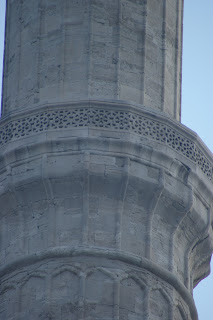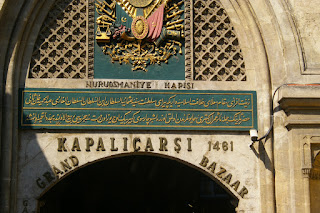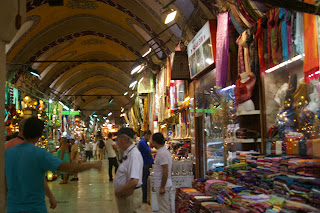Another very early morning, up at dawn and back in the late afternoon. Would it be worth the effort? Every bit so and then some. Before the cruise I thought that Turkey, particularly Istanbul, would be my least favorite port. I was pleasantly surprised by how much I loved this city. Istanbul is so different from my neck of the woods. I loved the bus ride and looking down the streets and alleys to see the people, the shops and their way of life. I loved the different culture with the old and new influences and traditions of it's people, 95% of the population is Muslim. The architecture is so different, the skyline is dotted with Mosques with their distinct shapes of large domes and minarets. The city of Istanbul lies on two continents, the old historic section that we're visiting is in Europe, the more business and residential section, across the straight of Bosphorus, is in Asia. We're staying in Europe today but on tomorrows stop I'll be in Asia. As my dad used to jokingly say, "Who'd of thunk it?"
This was a very full day, we visited the Hagia Sophia, The Grand Bazaar, The Blue Mosque and the Topkapi Palace, so let's get started with some photos from the bus window on our way to the Blue Mosque.
 |
| Our tour buses lined up for the day. |
 |
| The grand Blue Mosque. |
 |
| I'd like to tell you what this is but I don't know. A sidewalk cafe? A bus stop? It's a cool structure none the less. |
 |
| Another view of the Blue Mosque |
 |
| Many restaurants were empty due to the holy month of Ramadan. |
We are visiting during Ramadan, the holiest month of the year for Muslims. The dates of Ramadan move backwards each year by approximately 11 days, so in the course of 34 years Muslims will have fasted every day. Our guide explained the importance of Ramadan and that it's so much more than just not eating. There is no smoking, eating or drinking allowed in the daylight hours, there are extra prayers and one of the most important parts of Ramadan is charity. This is a time for great charitable works by the Muslim community. They used to find a needy family and give directly to them but lately they are giving more globally. There are signs throughout the city asking for donations for the earthquake victims in Japan and the famine victims in Africa. It's a time for reflection, kindness, doing the right thing and many good deeds. Our lovely and oh so smart guide told us that there was a large religious ceremony at the Blue Mosque the night before so the clean up would delay the opening which in turn would mean long lines. She decided that we should visit Hagia Sophia first, it was right next door.
The Hagia Sophia has a quite a history; originally built in the early first century as a Orthodox church, The Cathedral of Constantinople. Hagia Sophia was the largest church in the world until the construction of St. Peter's in Rome. In 1453 it was converted into a mosque and before that for a brief period (1204 to 1261) it was a Roman Catholic cathedral. In 1935 it was opened as a museum. When it was converted to a mosque all of the Christians mosaics were not destroyed but instead covered with plaster. Now as a museum the plaster has been removed and it's filled with Christian and Muslim religious representation, the way it should be. The Muslims believe that no man is better than another, therefore there are no pictures of Mohammed or other prophets in the mosques but there are signs in Arabic referring to Allah.
 |
| The beautiful Hagia Sophia |
Let's go inside, shall we?
 |
| Look how tall this door is, it should help give you a visual for how massive the building is. |
 |
| The indentation in this marble floor is where the guards stood over the centuries. |
 |
| A solid marble sculpture brought over from the ancient city of Pergamon in the late 1500's |
 |
| This is the Mihrab, which is the niche that tells the worshipers the direction of Mecca for their prayers. |
 |
| This is a minbar where the Imam delivers the sermon. |
 |
| Christian symbol in the middle and Islam on the outside. |
 |
| So grand. |
 |
| The large writing at the bottom is Arabic for Allah. |
My pictures are not worthy of the Hagia Sophia, I'd suggest that you either Google it or better yet visit yourself. Next up is our trip to the Grand Bazaar with over 4000 shops but as Louis (our excursion desk manager) told us they only have 12 things for sale. Construction started in the 15th century and they haven't stopped adding stores. It's massive but it did seem like The Red Barn Flea Market where every other stall sold the same thing.
First is our obligatory stop at the host nations manufacturing facility, today's product is the Turkish carpet. I must admit they were beautiful but so was the furniture in Italy.
 |
| A master carpet weaver. |
 |
| She makes these carpets from sight, she looks at a picture. |
I loved the beautiful carpets but I think Target sells cheap imitations for 1/100th the cost. :) On to the Grand Bazaar, and the photo stops along the way.
 |
| These are evil eyes, if you buy one and carry with you at all times you'll be protected from evil. |
 |
| Turkish Delight, I was told it was a little like taffy with fruity flavors. |
 |
| Lunch anyone? Chicken on the left, lamb on the right. |
 |
| The Turkish flag. |
 |
| Belly dancing anyone? |
 |
| Simit, or sometimes referred to as a Turkish bagel. Available at every street corner. |

Lunch time and then off to the Blue Mosque, which got it's name for the blue tiles inside. The correct name is Sultan Ahmed Mosque. The building is stunning inside and out. According to our tour guide each of those blue tiles is worth $5,000.00. In Islam the women can't pray with the men so they used to pray on the second floor. When a few of the blue tiles disappeared (likely from the tourists that were allowed up there at the time), the second floor was closed and the women were moved to the back of the church to pray. There are opaque fences with gates around the women's prayer area that makes it difficult to see in or out. The women also have a separate entrance than the men. Before entering the mosque we all had to have our knees and shoulders covered, including the men, however there was no requirement for scarfs on our heads. At the entrance there were two men passing out large scarfs for the inconsiderate and rude people who showed up in short shorts and tank tops, personally I think they should of just not been allowed inside. We were given a plastic bag by our guide to put our shoes in, as we had to remove them to enter.


 |
| In the courtyard. |
 |
| How magnificent! |
 |
| Leaving the mosque after prayer from the women's entrance. |
 |
| Before men enter the mosque they must wash their face and head, hands and arms and feet and ankles. I didn't see any women performing this ritual, if it's required by women I'm sure it's done in private |
 |
| I think this gentleman was posing as an Ottoman Turk for the tourists. |
 |
| I love this architecture. |
 |
| Reading of the Koran |
 |
| The faithful. |
You should notice a theme with these photographs, the shots inside are not nearly as good as the ones outside. Partly because I'm not the best photog but I also chose not to use the flash in many of these ancient places. Sometimes we were told not to use the flash but I kept mine off intentionally just in case it may cause some damage.
From here we went to the Topkapi Palace, I've never seen so much wealth in one place in my life. The palace is where the Ottoman Sultans lived for 400 years. Upon entering there were guards with machine guns, that made me slightly uncomfortable until I saw the treasures they were protecting. At the end of the Ottoman Empire the new state of Turkey decreed that this palace would be a museum.
The life of the Sultans was fascinating and so different from western cultures. First of all, when a man became the Sultan all of his brothers were killed so that there would not be a power struggle. When one of the Sultans died without an heir they had to rethink that plan. After naming a new Sultan, they killed all but one of his brothers, whom they locked up for 20 years. The ruling Sultan died without an heir, so they named his brother the new sultan, only to find out that he was insane from all those years of isolation. The woman's quarters at the palace was called a harem and the most powerful woman in the harem was the Sultan's mother called Queen Mother. She could have the wife of the Sultan killed if she so desired. The harem consisted of mother, daughters, sisters, slaves, lovers, concubines, wives, etc.
CAUTION, PARENTAL CONSENT REQUIRED
Black African males from Sudan and Darfur were taken to a monastery as young boys and castrated about the age of 8. Their penis and testicles were cut off and then they were buried in sand to their head for a period of time. The survival rate was 10% making these type of Eunuchs quite valuable. The purpose of this brutality was to have guards for the harem that the the Sultan could trust not to have relations with the women. There is no end to the violence that men are capable of.
I was not permitted to take any pictures in the treasury, however what follows are shot of the palace and the incredibly gorgeous views from the grounds.
 |
| The grounds were beautiful. |
 |
| Looking across the straight into the Asian half of the city. |
 |
| Our tour guide said she crosses continents daily for her job. |
 |
| The more modern Asian section. |
 |
| I wouldn't mess with this guy. |
 |
| This is some type of pipe I believe. |
 |
| One of the many courtyards. |
 |
| Intricately designed rooms. |
 |
| The same blue tile that's in the Blue Mosque. |
 |
| Bedroom of the Sultan. |
 |
| Domed ceiling |
 |
| Sitting room |
 |
| The large courtyard. |
I couldn't take pictures in the treasury rooms so I'll try to describe what I saw. There was an 86 carat diamond surrounded by other diamonds, a gold baby cradle, many cups and saucers studded with emeralds and rubies, Sultans sword with diamonds and enormous emeralds embedded in the gold sheath. I saw headpieces with emeralds the size of half dollars, entire thrones made of gold and studded with precious stones. Mainly the stones were emeralds, rubies and diamonds but I also saw some sapphire, pearl and jade. Some of this treasure were gifts to the Sultans, some of it was spoils of war and some was made by palace craftsmen.
What an interesting place and we only scratched the surface, it was already time to head back to the ship. On the walk to board we heard one last time the call to prayer which is quite beautiful. Istanbul was amazing and one of my absolute favorite stops on this cruise. The friendly people, clean streets and the ability of it's citizens to share it's treasures and culture with the rest of the world make it a top pick for me.
Tomorrow we are going to Kusadai, Turkey which is the main port for visiting the ancient city of Ephesus. I feel so young compared to these places I'm visiting.


















































































































































































No comments:
Post a Comment